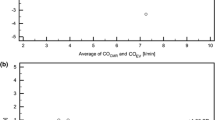Abstract
Noninvasive measurement of cardiac output (CO) and particularly stroke volume (SV) remain difficult but potentially valuable. These variables can be particularly challenging to measure in children with congenital heart disease (CHD). Impedance cardiography (IC) is a technique shown to be accurate in measuring SV in adults and in children with structurally normal hearts. The ease of use and rapidity of SV measurement using IC makes it potentially attractive for young patients with CHD. Advances in IC technology have led to more sophisticated signal-morphology IC (SMIC) devices that may further improve accuracy. We tested the accuracy of SMIC to measure SV in 21 subjects with CHD by comparing measurements with those from cardiac magnetic resonance (CMR) imaging. There was good agreement between SMIC and CMR in measurement of SV: mean difference = 1.7 ml (p = 0.47); r = 0.89. The agreement and correlation persisted when controlling for the differences in blood pressure and heart rate during the two testing methods. We conclude that SMIC is accurate at measuring SV and thus CO when compared to CMR in a variety of forms of CHD.


Similar content being viewed by others
Abbreviations
- D-TGA:
-
Dextro-transposition of great arteries
- PA:
-
Pulmonary atresia
- VSD:
-
Ventricular septal defect
- IAA:
-
Interrupted aortic arch
- TOF:
-
Tetralogy of Fallot
- TAP:
-
Trans-annular patch
- CoA:
-
Coarctation of Aorta
- AV:
-
Aortic valve
- AS:
-
Aortic stenosis
- TR:
-
Tricuspid regurgitation
- HCM:
-
Hypertrophic cardiomyopathy
- AI:
-
Aortic regurgitation
- PS:
-
Pulmonary valve stenosis
- ASD:
-
Atrial septal defect
- PAPVR:
-
Partial anomalous pulmonary venous return
- IVS:
-
Intact ventricular septum
- ASO:
-
Arterial switch operation
References
Pugsley J, Lerner AB (2010) Cardiac output monitoring: is there a gold standard and how do the newer technologies compare? Semin Cardiothorac Vasc Anesth 14:274–282. doi:10.1177/1089253210386386
Powell AJ, Maier SE, Chung T, Geva T (2000) Phase-velocity cine magnetic resonance imaging measurement of pulsatile blood flow in children and young adults: in vitro and in vivo validation. Pediatr Cardiol 21:104–110. doi:10.1007/s002469910014
Saur J, Fluechter S, Trinkmann F, Papavassiliu T, Schoenberg S, Weissmann J, Hagdi D, Borggrefe M, Kaden JJ (2009) Noninvasive determination of cardiac output by the inert-gas-rebreathing method—comparison with cardiovascular magnetic resonance imaging. Cardiology 114:247–254. doi:10.1159/000232407
Warburton DE, Haykowsky MJ, Quinney HA, Humen DP, Teo KK (1999) Reliability and validity of measures of cardiac output during incremental to maximal aerobic exercise. II. Novel techniques and new advances. Sports Med 27:241–260. doi:10.2165/00007256
Kemps HM, Thijssen EJ, Schep G, Sleutjies BT, De Vries WR, Hoogeveen AR, Wijin PF, Doevendrans PA (2008) Evaluation of two methods for continuous cardiac output assessment during exercise in chronic heart failure patients. J Appl Physiol 105:1822–1829. doi:10.1152/japplphysiol.90430.2008
Tonelli AR, Alnuaimat H, Li N, Carrie R, Mubarak KK (2011) Value of impedance cardiography in patients studied for pulmonary hypertension. Lung 189:369–375. doi:10.1007/s00408-011-9299-y
Richard R, Lonsdorfer-Wolf E, Charloux A, Doutreleau S, Buchheit M, Oswald-Mammosser M, Lampert E, Mattauer B, Geny B, Lonsdorfer J (2001) Non-invasive cardiac output evaluation during maximal progressive exercise test, using a new impedance cardiograph device. Eur J Appl Physiol 85:202–207. doi:10.1007/s004210100458
Charloux A, Lonsdorfer-Wolf E, Richard R (2000) A new impedance cardiography device for the noninvasive evaluation of cardiac output at rest and during exercise: comparison with the “direct” Fick method. Eur J Appl Physiol 82:313–320. doi:10.1007/s004210000226
Welsman J, Bywater K, Farr C, Welford D, Armstrong N (2005) Reliability of peak VO2 and maximal cardiac output assessed using thoracic bioimpedance in children. Eur J Appl Physiol 94:228–234. doi:10.1007/s00421-004-1300-5
Taylor K, La Rotta G, McCindle B, Manlhiot C, Redington A, Holtby H (2011) A comparison of cardiac output by thoracic impedance and direct Fick in children with congenital heart disease undergoing diagnostic cardiac catheterization. J Cardiothor Vasc Anesth 25:776–779. doi:10.1053/j.jvca.2011.05.002
Taylor K, Manlhiot C, McCindle B, Grosse-Wortmann L, Holtby H (2012) Poor accuracy of noninvasive cardiac output monitoring using bioimpedance cardiography [PhysioFlow ®] compared to magnetic resonance imaging in pediatric patients. Anesth Analg 114:771–775. doi:10.1213/ANE.0b013e318246c32c
Lababidi Z, Ehmke DA, Durnin RE, Leaverton PE, Lauer RM (1971) Evaluation of impedance cardiac output in children. Pediatrics 47:870–879
Bour J, Kellett J (2008) Impedance cardiography: a rapid and cost-effective screening tool for cardiac disease. Eur J Int Med 19:399–405. doi:10.1016/j.ejim.2007.07.007
Acknowledgments
The CTRI is partially supported by the National Institutes of Health Grant UL1TR001442. We would like to thank NeuMeDx for loaned equipment (PF-05 Lab1) during the study period.
Author information
Authors and Affiliations
Corresponding author
Ethics declarations
Conflict of interest
The authors have no conflicts of interest to report.
Rights and permissions
About this article
Cite this article
Ebrahim, M., Hegde, S., Printz, B. et al. Evaluation of Impedance Cardiography for Measurement of Stroke Volume in Congenital Heart Disease. Pediatr Cardiol 37, 1453–1457 (2016). https://doi.org/10.1007/s00246-016-1456-x
Received:
Accepted:
Published:
Issue Date:
DOI: https://doi.org/10.1007/s00246-016-1456-x




